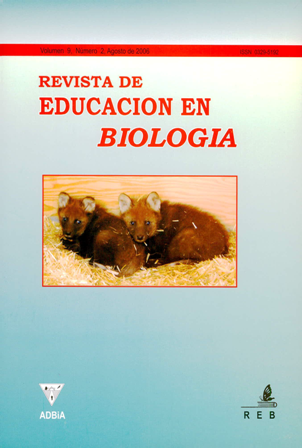The answers of the students of the Cycle of Specialization on evolutionary themes, and their relation with theological and anthropomorphic conceptions
Main Article Content
Abstract
Two peculiar explanations are used in Biological Sciences besides the causal one: teleological and anthropomorphic formulations. Teleological explanation considers the result of a phenomenon as the main reason of its occurrence, while the latest takes into account the assignment of human reasoning to entities that are not. The aim of this study was, on the one hand, to determine if the Lamarckian responses about evolutionary processes are related to teleological and anthropomorphic conceptions, and vice versa; and on the other hand, if the course, sex and knowledge declared by students about evolutionary and physiological issues correlates with them. It is also discussed this relationship and the didactic emerging consequence.
Article Details

This work is licensed under a Creative Commons Attribution-NonCommercial-ShareAlike 4.0 International License.
Aquellos autores/as que tengan publicaciones con esta revista, aceptan los términos siguientes:- Los autores/as conservarán sus derechos de autor y garantizarán a la revista el derecho de primera publicación de su obra, el cuál estará simultáneamente sujeto a la Licencia de reconocimiento de Creative Commons que no se permite un uso comercial de la obra original ni de las posibles obras derivadas, la distribución de las cuales se debe hacer con una licencia igual a la que regula la obra original.
- Los autores/as podrán adoptar otros acuerdos de licencia no exclusiva de distribución de la versión de la obra publicada (p. ej.: depositarla en un archivo telemático institucional o publicarla en un volumen monográfico) siempre que se indique la publicación inicial en esta revista.
- Se recomienda a los autores/as difundir su obra a través de Internet (p. ej.: en archivos telemáticos institucionales o en su página web) después del proceso de publicación, lo cual puede producir intercambios interesantes y aumentar las citas de la obra publicada. (Véase El efecto del acceso abierto).
How to Cite
References
Ayuso, G. E. y Banet. E. 2002. Alternativas a la enseñanza de la genética en la escuela secundaria, EJISCJ1WI:a de b.c Ciencias, 20(1), pp. 133-157.
Bachelard. G. 1938. La formación del espíritu cientifico. Siglo XXI, Buenos Aires.
Bermudez, G. 2005. La diversidad biológica y los disturbios. Desde el patio de la escuela a los parques nacionales. En: De Longhi, AL..; Ferrcyra,A.; Paz, A.; Bernifidez, 0.; Solis, M.; Vaudagna, E.; Cortcz, M. 2005. Estrategias de enseñanza de Ciencias Naturales en el nivel medio. Ed. Universitas, Córdoba. pp: 53-84.
Bishop, B. A. y Anderson, C.W. 1990. Student conceptions of natural selection and its role in evolution., formal of Research in Science Teaching, 27, pp. 4 15-427.
dough, E. E. and Wood-Robinson, C. 1985. How secondary students interpret instances of biological adaptation, Journal of Biological Education, 19,pp. 125-130.
Deniastes, S. S., Good, R.G., Peebles, P. 1996. Patterns of conceptual change, Journal of Research in Science Teaching, 33. pp. 407-431.
DiSessa, A. A. 1993. Towards an epistemology of physics, Cognition and Instruction, 10, pp. 101-104.
Driver. R.; Squires, A.; Rushwonth, P.; Wood-Robinson, V. 1999. Dando sentido a la ciencia en secundaria. Visor, Madrid.
Ferrari, M. y Chi, M. T. H. 1998.The nature of naive explanations of natural selection, Journal of Research in Science Education, 20 (10), pp.123 1-1256.
Friedler, Y., Zohar, A. y Tamir, P. 1993. The effect of age and of learning on the ability to distinguish between anthropomorphic and teleological explanations, International Journal of Science Education, 15(4), pp. 439-443.
Gonzalez Galli, L. M.; Mcinardi, E. 2005. Estudio de las concepciones post-instruccionales acerca de la teoría de la evolución en estudiantes, profesores y licenciados en biologia. Memorias VI .Jornadas Nac. I Congreso Intemnacional de Enseñan:a de Ia Biologia. ADBIA, Buenos Aires. pp: 164-167.
Grau, R.; Manuel, J. 2002. Enseflar y aprender evolución: una apasionante carrera de obstáculos, Alamnhique: Didcictica c/c los Ciencias Experimentales, IX(32), PP 56-64.
Jiménez Aleixanidre, M. P. 1990. Los esquemas conceptuales sobre la selección natural: análisis y propuestas para un cambio conceptual. Enseñanza de las Ciencias, 8(3), pp. 297-299.
Jiménez Aleixandre, M. P. 1991. Cambiando las ideas sobre el cambio biológico, Enseñanza de las Ciencias, 9(3), pp.248-256.
Jiménez Aleixandre, M. P. 1998. Concepciones sobre algunas especies. Animales: ejemplificaciones. Del razonamiento por categorías. Dificultades de aprendizaje asociadas, Enseñanza de las Ciencias, 16 (1), pp. 147-157.
Jirnénez Aleixandre, M. P. 2002. Aplicar la idea de cambio biológico: por qué hemos perdido el olfato?, Alambique. Didáctica de las Ciencias Experimentales, 32, pp. 48-55.
Lopez ManjOn, A. 1996. La explicación teleológica en la enseñanza y aprendizaje de la biologia. En Carretero, M., 1996. Construir y Enseñar las Ciencias Experimentales. Aique, Buenos Aires.
Paz, A. y Bcrrnudez, G. 2005. La adaptación de los piojos a los insecticidas: un problema cotidiano para aprender evolución. En: Dc Longhi, A. L. et al. 2005. Estrategias de enseñanza de Ciencias Naturales en el nivel medio. Ed. Universitas, Córdoba. pp: 105-116.
Pozo, J. I. y Carretero, M. 1989. Las explicaciones causales de expertos y novatos en historia, La Enseñanza de las Ciencias Sociales, 8(3), pp. 48-56.
Pozo, J. I. y Gómez Crespo, M.A. 1998. Aprender y enseñar ciencia. Del conocimiento cotidiano al conocimiento científico. Ediciones Morata, Madrid.
Prevosti, A. 1997. La adaptación en Biologia, Alambique. Didáctica de las Ciencias Experimentales, 11, pp. 93-101.
Richardson, D. R. 1990. A survey of students notions of body function as teicologic or mechanistic. Advances in Physiology Education, pp. s8-10. Journal of Research in Science Teaching, 3 1, pp. 449-458.
Settlagc, J. 1994. Conceptions of natural selection: a snapshot of the sense-making process.
Strickbcrger, M,, W. 1993. Evolucidn. Ediciones Omega, Barcelona.
Vaudagna, E. 2004. Representaciones del alumnado sobre ci VIH/SIDA. Un estudio en la ciudad de Córdoba. Revista de Educación en Biología,
7(2), pp. 9-15.
Watts, M. y Bentley, D. 1994. Humanizing and feminizing school science: reviving anthropomorphic and animistic thinking in constructivist science education, I,uernational Journal of Science Education, 16(1), pp. 83-97.
Zohar, A. y Girtossar, S. 1998. Lifting the taboo regarding Teleology and Anthropomorphism in biology education- heretical suggestions. Science
Education, 82 (6), pp. 679-697.

